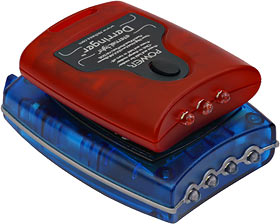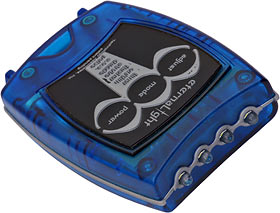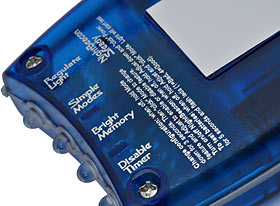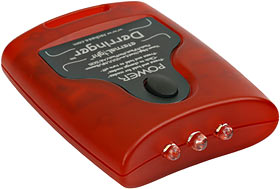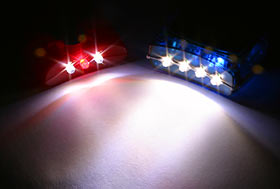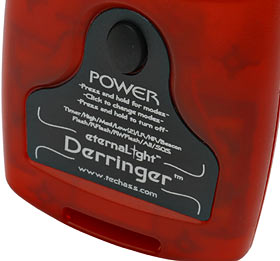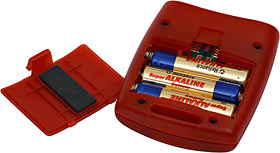
EternaLight EliteMax and Derringer
Review date: 17 October 2003.Last modified 03-Dec-2011.
Technology Associates made the first LED flashlight I ever bought.
Also the last, now that I think of it.
Their "EternaLight" series of flashlights has been around for some time now, and they're deservedly popular. They run from normal AA cells, they use four LEDs (usually, but not always, white) for respectable brightness, and they have microprocessor control, which allows them to do things most flashlights can't.
Brightness control, for instance.
Most flashlights are on, or they're off. Which is fine, except when you don't need anything like full brightness. A monster light cannon is all very well if you need to signal UFOs or stun perpetrators, but it's overkill for many purposes, and can be actively counter-productive.
If you only need a little light to read a book as you sit in your tent, or if you want to preserve your night vision and anonymity as you stalk your favourite celebrity, or if you just want the flashlight's batteries to last longer, lower brightness settings are excellent.
The battery life difference can be big. The EternaLights I reviewed back in '01 draw about 130 milliamps (mA) from their batteries at full power, but a scant 3.5mA for their lowest brightness mode, (where only one of the LEDs is illuminated, and that one dimly).
Add to that various other flash and signal modes, solid waterproof construction and an odd but comfortable pager/phaser shape that makes it easy to operate the three rubber-membrane control buttons with your thumb, and the EternaLights are an attractive package for the money.
So here are the latest EternaLights. One's at the top of the range, one's at the bottom.
Let's look at the fancy one first.
To the Max
$US99 is, from most people's point of view, a lot of money to pay for a flashlight - especially one that only delivers four 5mm white LEDs worth of light.
At full power, the EternaLight EliteMax's peak brightness is around 70 lux at one metre. That's a bit higher than most of the other EternaLights, because the EliteMax comes equipped with lithium AA cells. They're lighter than alkalines (an EternaLight with lithium cells will float; one with alkalines won't) and deliver a nominal 1.7 volts per cell, versus 1.5V for alkalines.
The EliteMax can operate at more than full power, though. If you press the Adjust button while the light's off, it'll light up in "Overdrive" mode while the button's held down, and deliver better than 80 lux at one metre from fresh lithium batteries.
This reading is from the middle of the flashlight's beam, which falls off smoothly towards the edges, like most LED light output. The EliteMax has a full beam width of around 90 degrees, with a central bright spot about half that width. This is a great beam for walking-around purposes, since it shows you what you're pointing the light at pretty well, without leaving nearby things in complete darkness. It's no good for long range use, though.
Now, 70 or 80 lux isn't that amazing compared with the output from lights that use the new breed of super-LEDs. A low-cost Luxeon Star flashlight like the CMG Reactor (reviewed here) can manage around three times the brightness of the EliteMax. The Reactor needs a couple of lithium AAs to do that, but the not-much-more-expensive Reactor 3 takes three alkaline AAs and is brighter still.
Drop larger dollars on an Arc-LS (reviewed here) or big old Elektro Lumens light (reviewed along with the Reactor) and you'll get even more output from the same kind of lamp.
But, as pocket lights go, the EliteMax is certainly usefully bright. And its ability to run at lower brightness is unusual. The only other non-keyring variable-brightness LED light I've checked out is the innovative Photon Fusion, reviewed here. But although the Fusion is many things a pocket light it ain't.
The basic EliteMax feature set is the same as that of the EliteXRay, which I reviewed here.
It's got a see-through blue casing with a blue LED inside it that can be set to a "NightBeacon" blink mode, so you can find your light in the dark.
It's got a magnet on the bottom, to stick the flashlight to ferrous surfaces.
It comes with a quality lanyard, and a little screwdriver for when you need to open the light and change the batteries.
And its basic operation modes are the same, and in the same sequence.
There's extra stuff, though...
...some of which is explained on the underside of the light, and the rest of which is explained in the manual (online in PDF format here).
The EliteMax has a voltage-boosting regulator, for a start, which means its three brightest modes won't get a whole lot dimmer for most of the life of the batteries. The downside of this is that the flashlight's current draw in those modes won't tail off as the batteries go flat; actually, it'll rise, killing the AAs a lot faster.
The EliteMax's rated regulated run time at full non-overdrive brightness, from alkaline AAs, is six hours (lithium AAs like the ones it comes with will last longer). That's until brightness drops to 20% of the fresh-battery score, but most of the drop will be right at the end of the six hours.
The brightness modes below the top three aren't regulated, and you can also turn regulation off for the brightest modes. Without regulation, full brightness mode is rated to take fifty hours to get down to 20% brightness, from alkalines - but the brightness slide will be a smooth curve, not a fairly flat line followed by a cliff.
There's a neat graph of this effect in the manual, which'll also tell you enough about the other functions that I'd just be repeating it if I listed them all here.
It bears mentioning, however, that this flashlight is so feature-packed that it needs a Configuration Mode.
That's where you turn regulation off, and it also lets you activate a Simple Mode that turns off everything but the initial Timer mode (which guards against accidental activation by dimming the light to nothing over a few minutes) and three brightness settings. You can also disable only Timer mode and keep everything else. Or switch the NightBeacon blue-LED mode between flash and steady-on.
There's also a Bright Memory setting, which is the most useful of the Configuration Mode options, if you ask me. It causes the flashlight to remember the brightness setting it had when you turned it off, and return to that setting when you turn it back on. No more default maximum brightness spoiling your night vision, or attracting the cops, before you manage to turn the light down.
The Battery Check feature's nifty, too, and quite easy to access; just hold Adjust and click the Mode button when the light's off, and it'll run at full brightness for five seconds to get a battery voltage reading, then flash its LEDs from one to four times to tell you the condition of the AAs.
There are some other noticeable differences between the EliteMax's behaviour and that of the older Ergo-series EternaLights I've checked out. You can dim the light manually in Timer mode, for instance, which is nice; the older lights required you to click on to the next mode before you could do that.
The medium brightness dimmer modes still operate by rapidly flashing the LEDs (which is more efficient than just feeding them fewer volts), but they now flash very rapidly. Waving the light around in front of your face shows the flashing lights as a series of overlapping crescents rather than a "string of beads".
The very dimmest modes now flash rather slowly, too, presumably for better battery life.
The "Dazzle" attention-attracting light sequence is slightly different, as well, and the "Pulse" mode no longer fades smoothly from low to high and back, but instead starts high, fades to low, then turns off the white LEDs and flashes the internal blue LED, before starting again.
On to the little one.
Little brother
The Derringer is Technology Associates' idea of a simple flashlight. Which is to say, it still has 13 operating modes, but at least there's only one button.
The Derringer is smaller than the other EternaLights; it's about 73 by 58 by 20mm in size (2.9 by 2.3 by 0.8 inches) and weighs around 64 grams (2.3 ounces) with batteries. The EliteMax is about 93 by 66 by 26mm (3.7 by 2.6 by 1 inch), and weighs around 112g (four ounces) with lithium AAs.
The Derringer's size reduction is made possible by the fact that the three cells it runs from are AAAs, not AAs.
The Derringer is also a cheapie, by EternaLight standards. It only costs $US29.99. But, unlike the other EternaLights, batteries aren't included.
The Derringer is solidly built, but not as solidly as the more expensive EternaLights. Its translucent red casing is still screwed together, but it'll creak if you squeeze it hard. And while it's quite adequately rainproof, it's not even rated as "water resistant", let alone waterproof.
Only two of the Derringer's three LEDs are white; the middle one's red. With all three lights blazing, its brightness peaked at about 30 lux at one metre. The red LED doesn't make much of a contribution, though; brightness without it on is only about 28 lux.
The Derringer control system is confusing only until you read the included instruction sheet. It's online in PDF format too, here.
Press the button and you get a momentary mode, identical to the momentary operation of the original olden-days "flashlights", back when battery capacity was lousy enough that turning your light on constantly would leave you in the dark in very short order.
Hold the Derringer's button down for two seconds, though, and it goes into a timer mode like the default mode for the other EternaLights. Now, holding the button for half a second turns the light off; clicking the button moves you to the next mode. It's simple, and it works.
And, once again, all of the modes are documented in the manual, so I won't ramble on about all of them here. Different brightness, different flash modes, three red-LED-only modes, and Morse Code SOS at the end of them all, again. The usual.
The Derringer's got a battery check mode, but all it does is turn on all three LEDs at full brightness - that's how I got the 30 lux figure above. Because the red LED runs from lower voltage than the white ones, it'll remain closer to its full brightness from very tired batteries than the white LEDs will. So if the red LED looks a lot brighter than the white ones in this mode, it's time for new AAAs. Simple.
Unlike all of the other EternaLights, the Derringer has an ordinary battery bay with a snap-catch lid. It ain't waterproof, childproof or bombproof, but it makes it very easy to change the batteries; no screwdriver is required.
Alternatives
If you've already got a regular EternaLight, there's no very good reason to upgrade to the EliteMax, unless you've just got to have its extra features.
And frankly, my favourite light in the Technology Associates range is still the Rave'n 2 (reviewed, I remind you, here). It's much more fun than a boring old white light, but its mix of colours means it's still usable for normal flashlight tasks - it's not like one-colour LED lights that make everything look like a Twilight Zone episode. And it only costs $US10 more than a Derringer.
If trippy coloured shadow-fringes just don't do it for you, the basic EternaLight Ergo costs the same as the Rave'n 2, which I think makes it a better bang-per-buck contender than the Derringer as well. The extra couple of white LEDs are worth $US10 by themselves.
The Derringer's smaller size and simplicity, though, could be big pluses for some buyers.
If you want a really tiny light with brightness control that you can hang off your key-ring, a Photon 3 (reviewed here) is probably the product for you. The lower brightness modes of the third-generation Photon are particularly useful for a key-ring light. The lithium coin cells that these tiny-lights run from do not like feeding an LED directly.
If you expect to use the light for more than a minute a day, though, even the low brightness Photon 3 modes won't give you great battery life. Even the humble AAAs in the Derringer will deliver a comfortable 20 times as much energy as the couple of coin cells in a Photon.
Overall
The Derringer gives Technology Associates a mass market product. It's bright enough for most domestic flashlight jobs, its one-button interface works well, and it's very pocketable. It wouldn't hurt if it were $US10 cheaper, but you can't have everything.
The EliteMax, in contrast, is the most nerd-friendly flashlight ever made. Sure, it's a hundred bucks - but compared with a lot of the toys that geeks buy for themselves, that's not terribly expensive. And the thing does everything but play Tetris.
If you're in the habit of losing your possessions, and you don't have money coming out of your ears, then an EternaLight is not for you. LED flashlights are still great, but gadget-misplacers should restrict their LED light purchasing to $5 Chinese cheapies on eBay. If they need something brighter, they should buy a 6V incandescent-bulb lantern from the supermarket. Zero nerd cred, but it'll get the job done.
If you don't lose your toys, though, the EternaLights are great products, and come Highly Recommended from me.
Review EternaLights kindly provided by Technology Associates.
